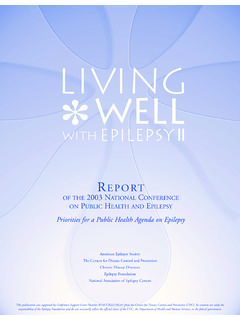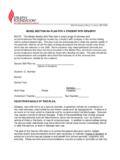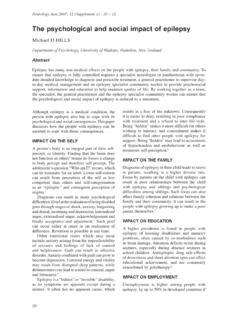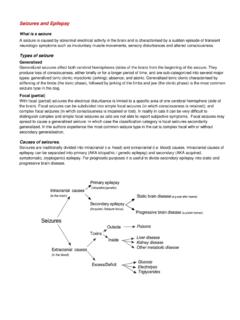Transcription of SEIZURES AND FIRST AID - Epilepsy Canada - HOME
1 Helping those with Epilepsy by giving them a better understanding of the condition and its treatmentSEIZURES ANDFIRST AID1 FIRST Aid and SeizuresSeIzuReS AnD FIRST AIDYou may have seen an epileptic seizure and not even realized it. Even if you aren t a trained health profes-sional, you can still learn some basic FIRST aid for dealing with SEIZURES . For people like you who deal frequently with the public, this pamphlet should help you recognize a seizure when it happens and know how to give basic FIRST aid if it s IS Epilepsy ?The term Epilepsy describes a common neurological condition that affects about 300,000 Canadians. Being able to recognize SEIZURES is important because they can sometimes be mistaken for something else. For example, the convulsion that a generalized tonic-clonic seizure causes may look like a heart attack and CPR may be used unnecessarily. A person who appears drunk or high on illegal drugs and is carrying Phenobarbital (an anticonvulsant drug) may actually be having a seizure .
2 SEIZURES happen when a surge of electrical energy passes between cells in a person s brain. This sudden overload may stay in just one small area of the brain or it could swamp the whole system. This changes behaviour, affects consciousness and causes unusual body movements. About one person in 100 has Epilepsy , the cause of which is unknown in 75 percent of the children who have it and half of the adults. This condition is not contagious at any CanadaTypeS oF SeIzuReSWhat different SEIZURES look like depends on which part of the brain was involved and how much of the total brain area was Tonic-Clonic SEIZURES The ones most people tend to think of when they hear the word Epilepsy Causes convulsions, which last from two to five minutes Complete loss of consciousness Muscle spasmsAbsence SEIZURES A blank stare lasting only a few secondsPartial SEIZURES Involuntary arm or leg movements Distorted sensations or a period of automatic movements in which awareness is blurred or completely absentSince the effects of SEIZURES vary, so does the way you need to react to them.
3 This pamphlet describes them in detail and how you should handle each type. Posting this on a bulletin board will ensure that people who deal with the public can easily access Aid and SeizuresGeneRAlIzeD TonIc-clonIc (formerly Grand Mal)What it looks like Sudden cry, fall Rigidity followed by muscle jerks Shallow or temporarily suspended breathing Bluish skin Possible loss of bladder or bowel control Usually lasts a couple of minutes before normal breathing resumes May be some confusion and/or fatigue and then a return to full consciousnessWhat it is Not Heart attack StrokeWhat to Do Look for medical identification Protect from nearby hazards Loosen tie or shirt collar Protect head from injury Turn on side to keep airway clear unless injury exists Reassure as consciousness returns If single seizure lasts less than five minutes, ask if hospital evaluation wanted If multiple SEIZURES , or if one seizure lasts longer than five minutes, call an ambulance.
4 If person is pregnant, injured or diabetic, call for aid at Not to Do Don t put any hard implement in person s mouth Don t try to hold tongue, it can t be swallowed Don t try to give liquids during or just after seizure Don t use artificial respiration unless breathing is absent after muscle jerks subside or unless water has been inhaled Don t restrain4 Epilepsy CanadaAbSence (formerly Petit Mal)What it Looks Like A blank stare, beginning and ending abruptly, last-ing only a few seconds, most common in children May be accompanied by rapid blinking, some chewing movements of the mouth Child or adult is unaware of what s going on during the seizure , but quickly returns to full awareness once it has stopped May result in learning difficulties if not recognized and treatedWhat it is Not Daydreaming Lack of attention Deliberate ignoring of adult instructionsWhat to Do No FIRST aid necessary, but if this is the FIRST observa-tion of the seizure (s)
5 , medical evaluation should be recommended5 FIRST Aid and SeizuresSImple pARTIAlWhat it Looks Like Jerking may begin in one area of body, arm, leg or face Can t be stopped, but person stays awake and aware Jerking may proceed from one area of the body to another and sometimes spreads to become a convul-sive seizure Partial sensory SEIZURES may not be obvious to an onlooker Person experiences a distorted environment May see or hear things that aren t there May feel unexplained fear, sadness, anger or joy May have nausea, experience odd smells and have a generally funny feeling in the stomachWhat it is Not Acting out, bizarre behaviour Hysteria Mental illness Psychosomatic illness Parapsychological or mystical experienceWhat to Do No FIRST aid necessary unless seizure becomes con-vulsive, then FIRST aid as general tonic-clonic SEIZURES No immediate action needed other than reassurance and emotional support Medical evaluation should be recommended6 Epilepsy Canadacomplex pARTIAl (also called Psychomotor or Temporal Lobe)
6 What it Looks Like Usually starts with blank stare, followed by chewing, followed by random activity Person appears unaware of surroundings May seem dazed and mumbles Unresponsive Actions clumsy, not directed May pick at clothing, pick up objects, try to take clothes off May run, appear afraid May struggle or flail at restraint Once pattern established, same set of actions usually occur with each seizure Lasts a few minutes, but post- seizure confusion can last substantially longer No memory of what happened during seizure periodWhat it is Not Drunkenness Intoxication or drugs Mental illness Disorderly conductWhat to Do Speak calmly and reassuringly to person and others Guide gently away from obvious hazards Stay with person until completely aware of environment Offer help getting homeWhat Not to Do Don t grab hold unless sudden danger (such as a cliff edge or an approaching car) threatens Don t try to restrain Don t shout Don t expect verbal instructions to be obeyed7 FIRST Aid and SeizuresATonIc (also called drop attacks)What it Looks Like A child or adult suddenly collapses and falls After 10 seconds to a minute person recovers, regains consciousness and can stand and walk againWhat it is Not Clumsiness Normal childhood stage In a child, lack of good walking skills In an adult, drunkenness, acute illnessWhat to Do No FIRST aid needed (unless person hurt while falling)
7 , but a child should be given a thorough medical evaluationmyoclonIcWhat it Looks Like Sudden brief, massive muscle jerks that may involve the whole body or parts of the body May cause person to spill what they were holding or fall off a chairWhat it is Not Clumsiness Poor coordinationWhat to Do No FIRST aid needed, but person should be given a thorough medical evaluation8 Epilepsy CanadaInFAnTIle SpASmSWhat it Looks Like These are clusters of quick, sudden movements that start between three months and two years If a child is sitting up, the head will fall forward and the arms will flex forward If lying down, the knees will be drawn up, with arms and head flexed forward as if the baby is reaching for supportWhat it is Not Normal movements of the baby ColicWhat to Do No FIRST aid, but doctor should be consultedSTATuS epIlepTIcuSWhat it Looks Like Single seizure lasts more than 30 minutes with, or without, impaired consciousness Repeated SEIZURES last more than 30 minutes with impaired consciousness in between SEIZURES Can occur with trauma Often occurs after abruptly stopping anticonvulsant drugs Can be life-threatening if not treated immediatelyWhat to Do Call ambulance or rush to hospital emergency ward9 FIRST Aid and Seizuresno AmbulAnce neeDeD Medical jewellery or card says Epilepsy , and The seizure ends in under five minutes, and Consciousness returns without further incident, and There are no signs of injury, physical distress or pregnancycAll An AmbulAnce The seizure has happened in water There s no medical and no way of knowing whether the seizure is caused by Epilepsy The person is pregnant.
8 Injured or diabetic The seizure continues for more than five minutes A second seizure starts shortly after the FIRST one has ended Consciousness doesn t begin to return after the shaking has stoppedIf consciousness is regained before the ambulance arrives, the person should be asked if the seizure was associated with Epilepsy and if a trip to the hospital is CanadaheAD FoR The emeRGency Room uncomplicated convulsive seizure in someone with Epilepsy isn t a medical emergency if it stops naturally after a few minutes without any ill effects. After resting, the average person can go about his/her business and may need only limited, if any, help in getting home. Occasionally a seizure won t stop naturally, and several other medical conditions can be the cause. These include: Diabetes Heat exhaustion Poisoning High fever Brain infections Pregnancy Hypoglycemia Head injuryWhen SEIZURES are continuous or any of these condi-tions exist, immediate medical attention is Aid and SeizuresFIRST AID FoR SEIZURES In SpecIAl cIRcumSTAnceSIn WaterRemove the person as quickly as possible, while supporting the body and keeping the head tilted.
9 The head and face should stay above the surface. Once on dry land, examine the person and begin artificial respiration immediately if he/she isn t breathing. The person should be taken to the emergency of a local hospital for a careful medical check-up, even if he/she appears to have fully recovered from the seizure . Inhaling water can cause heart or lung an AirplaneIf possible, help the person lie across two or more seats with the head and body turned on one side. Once consciousness has been fully regained, help the person into a resting position in a single reclining seat. If there aren t any empty places, recline the person s seat. Once the seizure s rigidity phase has passed, turn the person gently in the seat so that he/she is leaning towards one side. You can arrange pillow or blankets to protect the person s head from hitting unpadded areas of the plane, but make sure the person is sitting at an angle that keeps the airway clear and breathing is a BusLie the person across a double or triple seat, turn the person on the side and follow the same steps as indicated above.
10 A person who has fully recovered from a seizure can stay on the bus until arriving at his/her CanadaFoR polIce oFFIceRS: Epilepsy AnD DRuGSDespite medical progress, Epilepsy generally cannot be cured. But with regular daily use of anti- seizure drugs called anticonvulsants, SEIZURES can be completely con-trolled or significantly reduced in most individuals. People with Epilepsy usually carry medication with them because they may have to take it up to four times a day. They risk having a seizure if they miss a scheduled dose. The following are brand and generic names of drugs most commonly used to treat Epilepsy : Ativan (Lorazepam) Depakene (Valproic Acid) Diamox (Azetazolamide) Dilantin (Phenytoin) Epival (Divalproex Sodium) Frisium (Clobazam, Benxodiazepine) Keppra (Levetiracetam) Lamictal (Lamotrigine) Luminal (Phenobarbital, Barbiturate) Mogadon (Nitrazepam) Mysoline (Primidone) Neurontin (Gabapentin) Rivotril (Clonazepam, Benzodiazepine) Sabril (Vigabatrin) Tegretol (Carbamazepine) Topamax (Topiramate) Trileptal (Oxcarbazepine) Valium (Diazepam, Benzodiazepine) Zarontin (Ethosuximide Succinimide) Zonegran (Zonisamide)People with Epilepsy can be prescribed more than one drug.





